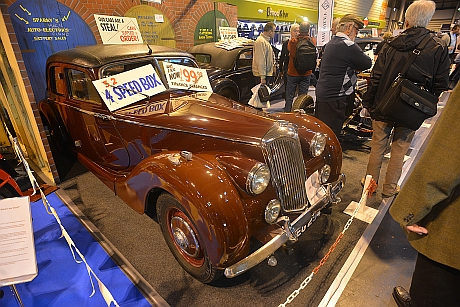Riley Tyres



Classic Riley Tyres
On the following pages, Longstone Classic Tyres give classic tyre fitment recommendations for Riley cars.
If your car is not listed, don't panic! Please give us a call on:
01302 711 123
or
Email: sales@longstonetyres.co.uk
Vintage Riley Tyres
Longstone Tyres can provide tyres for across the whole Riley range, from the Pininfarina designed Riley 4 to the more traditional Riley Pathfinder.
Riley Tyres
The following list are our recommendations for Rileys:
- 185 SR 16 Michelin X for a 1 1/2-Litre RME & Pathfinder (Pre-1955).
- 185 VR 16 PIRELLI CINTURATO CA67 for a 2 1/2-Litre RMF & Pathfinder (Post-1955).
- 165 HR 14 Michelin XAS for a Riley 4/68 & 4/72.
- 4.50x19 Ensign B5 for a Riley 9.
Riley History

Riley's first automobile was a modest single-cylinder belt-driven light car that was never produced. In 1900, motor tricycles were introduced, and in 1903, a handlebar-steered tricar with two speeds powered by a 517cc engine with mechanically actuated inlet valves was introduced. Tricars were manufactured until 1907, with later models including twins with drivers' seats (instead of saddles), water cooling, and a steering wheel. The 1034cc V-Twin motor was also used in the company's first four-wheelers.
From 1908 onwards, larger V-Twins with 2-litre capacities, more conventional layouts, and circular radiators were produced. In 1914, two-cylinder automobiles were still produced, but the Riley Engine Co. also developed a new 2.9-litre side-valve four-cylinder with worm final drive for a short period following World War I.
The 11s were the first Rileys built following World War I, featuring side-valve 1.5-litre engines, alloy pistons, and complete electrical equipment. In 1923, the Redwinger sports version (wire wheels and polished aluminium body) debuted, with a maximum speed of 70 mph. Side-valve automobiles with 1645cc engines were manufactured until 1928. The Monaco cloth saloon debuted in 1926 and was an instant success. There was also a Brooklands Sports that had been lowered and adjusted, with a twin-carburettor engine and a top speed of 80 mph. In 1929, a twin-carburettor touring 'Nine' was released.

Rileys had an excellent competitive record. Riley automobiles earned three Gold medals and seventeen Silver medals in the 1925 London-Exeter-London Trial, and they had the most finishing cars out of 152 entries. Today Riley still has a huge number of devoted members in all regions of the United Kingdom, as well as a number of abroad members.
Class victories in the 1929, 1930, and 1931 TTs were followed by an outright triumph in 1932 and two subsequent wins by a 1.5 litre in 1935 and 1936. The ERA racing vehicles were based on the 6-cylinder racing Rileys of 1933/34. Both the 'Nine' and the 14/6 evolved gradually, with the former receiving a reduced frame and semi-panelled body in 1932 and an optional preselector transmission in 1934, which subsequently became standard. In 1932, a Super-Sports 6-cylinder 1.5 litre emerged, followed by the Mentone, the Kestrel, and the more traditional Falcon.
In 1934-35, two sports 2-seaters were produced: the 9 Imp and the 1633cc 6-cylinder MPH, which could reach speeds of over 90 mph. For competitive purposes, this automobile could alternatively be ordered with a 1.5-litre engine. Another new model in 1935 was the 112 litre four (with preselector gearbox, rod operated Girling brakes, and central chassis lubrication system) in single or twin carburettor versions, with later developments including the 85 mph Sprite two-seater, the Kestrel Sprite saloon, and the Lynx Sprite tourer, which offered more space with the same highly-tuned engine.

Riley's financial uncertainty led to the company's acquisition by the Nuffield Organisation in 1938. Only the 1.5 litre and the Big 4 models were kept in production. They featured disc wheels, synchromesh transmissions, and Wolseley-style bodywork. The post-war successors used the same engines but had more appealing bodywork. Healey utilised the 2.5-litre engine from 1946 through 1954.
The 1.5 litre was continued after the Austin-Morris merger until 1955, with no alteration other than a change in wing design. The Pathfinder was released in 1954, with a body identical to the Wolseley 6-90 with a fresh chassis design, coil-spring rear suspension, and cam-type steering. The 1.5, the 4/68 with Farina style and a 1500cc engine, and subsequently the 4/72 with a 1622cc engine, all used twin-carburettors. In 1966, a new 1100 Kestrel was introduced, which was eventually upgraded to a 1300cc engine. The Riley Elf, a Mini with a bigger boot and a 948 cc engine, was also made. Rileys were ultimately phased out by British Leyland at the end of 1969, after 70 years of production.
